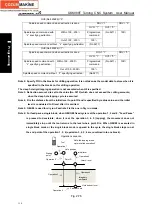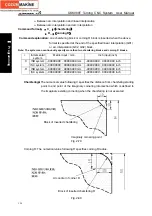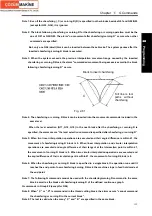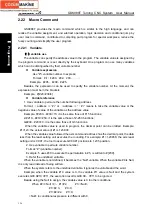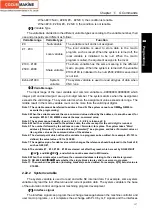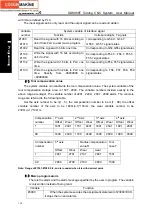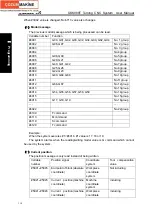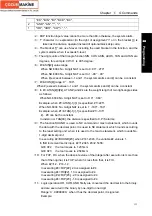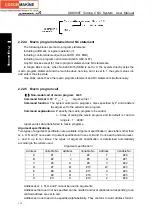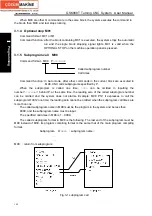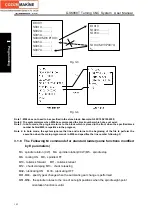
Chapter
Ⅱ
G Commands
127
Ⅰ
Programming
When #2=<Null>, #2 EQ #0
,
#2 NE 0, the condition is tenable.
When #2=0, #2 EQ #0
,
#2 NE 0, the condition is not tenable.
(
2
)
Variable Type
The variable is divided into the different variable types according to the variable number, their
use and prosperity are different as follows:
Variable range
Variable type
Function
#0
Null variable
The variable is null and is not assigned.
#1
~
#33
Local variable
The local variable is used to store data in the macro
program, such as result. When the system is turned off, the
local variable is initialized to be null. When the macro
program is called, the argument assigns to the local.
#100
~
#199
#500
~
#999
Share variable
The share variable has the same meaning in the different
macro program. When the system is turned off, the variable
#100~#199 is initialized to be null, #500~#999 is saved and
is not lost.
Behind
#1000 System
variable
The system variable is used to read all types of data when
CNC runs.
(
3
)
Variable range
The input range of the local variable and common variable is -99999999~99999999 which
integer part and decimal part are up to 8-digit number. The system alarms when the assignment
exceeds the valid range. The system alarms when the assignment value exceeds its range. The
middle result in the macro variable count can be more than the valid input digital.
Note 1: The variable cannot be referred to address O and N. The system cannot use O#200
,
N#220 to
execute the programming;
Note 2: When the variable exceeds the max. command value defined by the address, it cannot be used; for
example: #230 = 120: M#230 exceeds the max. command value;
Note 3: The system cannot identify –0 and + 0. # 4 = - 0: X # 4 is taken as X 0;
Note 4: When the variable is used to the address data, the other except for the valid digit is rounded.
Note 5: The number followed by the address can use <Formular> to replace. The system takes “Word
address [<Formular>]” or word address-[<Formular>]” as a program, and take <Formular> value or
its negative value as the command value of the address.
Note 6: The decimal point which defines the variable in a program can be omitted. For example, #1=123 is
defined, the actual value of #1 is 123.000;
Note 7: The negative sign of variable value which changes the reference should be placed in the front of #,
such as G00X-#1;
Note 8:The variable #1
~
#33, #100
~
#199 are cleared out after they reset, which are set by NO.6001Bit7
(
CLV
)
and Bit6
(
CCV
)
, and which cannot be executed in MDI mode;
Note 9: When the variable value overflows, the command address referring to the variable is ignored.
Note 10: NO.6000 Bit5
(
SBM
)
sets whether the single block stop is valid in user macro program.
Note 11: The number in expression (including brackets) can be omitted. For example, X[10] actual value is
X10.000.
2.22.2 System variable
The system variable is used to read and write NC internal data. For example, some system
variable only read the tool offset value and current position data. The system variable is the base
of the automatic control and general machining program development.
(
1
)
Interface signal
The interface signal can program the exchange message between the machine controller and
user macro programs, i.e. it completes the exchange with PLC by G, F signals and the interfaces
Summary of Contents for 988T
Page 6: ...GSK988T Turning CNC System User Manual VI ...
Page 14: ...GSK988T Turning CNC System User Manual XIV ...
Page 15: ...Chapter 1 Programming Fundamentals 1 Ⅰ Programming Ⅰ PROGRAMMING ...
Page 16: ...GSK988T Turning CNC System User Manual 2 Ⅰ Programming ...
Page 194: ...GSK988T Turning CNC System User Manual 180 Ⅰ Programming ...
Page 195: ...Chapter Ⅰ Overview 181 Ⅱ Operation Ⅱ OPERATION ...
Page 196: ...GSK988T Turning CNC System User Manual 182 Ⅱ Operation ...
Page 217: ...Chapter Ⅲ Windows 203 Ⅱ Operation ...
Page 267: ...Chapter Ⅲ Windows 253 Ⅱ Operation Fig 3 51 Fig 3 52 ...






